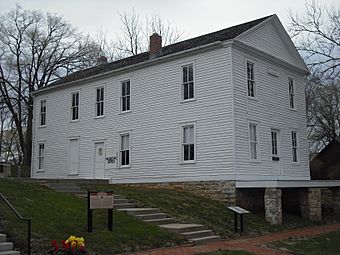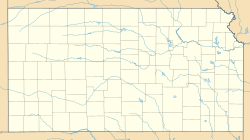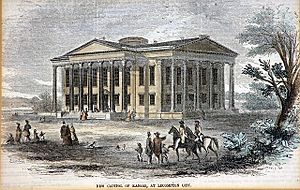Constitution Hall (Lecompton, Kansas) facts for kids
|
Lecompton Constitution Hall
|
|

Constitution Hall in Lecompton, Kansas
|
|
| Location | Elmore St. between Woodson and 3rd Sts., Lecompton, Kansas |
|---|---|
| Built | 1857 |
| NRHP reference No. | 71000312 |
Quick facts for kids Significant dates |
|
| Added to NRHP | May 14, 1971 |
| Designated NHL | May 30, 1974 |
Lecompton Constitution Hall, also known as Constitution Hall, is an important building in Lecompton, Kansas. It played a big part in a difficult time in Kansas history called Bleeding Kansas. This was a period of conflict over whether Kansas would become a state that allowed slavery or one that did not. Today, the Kansas Historical Society takes care of the building as the Constitution Hall State Historic Site.
Contents
History of Constitution Hall
Building a Key Place
Constitution Hall was built in 1857 by Samuel J. Jones. He was the sheriff in Douglas County and supported slavery. Sheriff Jones rented the building to the government of the Kansas Territory, which was based in Lecompton.
Busy Times in the Hall
In 1857, this building was one of the busiest and most important places in Kansas Territory. Many settlers came to the United States land office on the first floor. They wanted to claim their share of the rich lands that were becoming available. The government was moving Native American people from Kansas to open up these lands for white settlers.
Upstairs, the district court met regularly. It tried to enforce the laws of the territory. However, many people who were against slavery refused to follow these laws. They called the laws "bogus" because they were passed by a legislature that supported slavery. This made it very hard for officials to keep order. Sometimes, federal troops had to be called in from nearby forts to help.
Laws and Conventions
In January 1857, the second group of lawmakers for the territory met upstairs. Even though most of them supported slavery, they did change some laws that people against slavery disliked.
Later that year, a very important meeting happened in the same room. This was the Lecompton Constitutional Convention. Its goal was to write a constitution so Kansas could become a state. Reporters from all over the country came to cover the meetings.
The Lecompton Constitution
Men who supported slavery were in charge of this convention. They created a document, called the Lecompton Constitution, that would protect slavery in Kansas. This was true no matter how the people of the territory voted. People who were against slavery were very upset and refused to be part of what they saw as an illegal government.
Later, the United States Congress looked into the election of the proslavery legislature. They found that there was a lot of cheating. People from Missouri, called "border ruffians," came into Kansas just to vote illegally. Because of this fraud, Congress refused to let Kansas join the United States as a slave state under the Lecompton Constitution. So, it never became law.
A Shift in Power
After the Lecompton Constitution failed, people who were against slavery gained more power. They won control of the territorial legislature in October 1857. Just two months later, this new legislature met in the same Lecompton assembly hall. Here, they started to change the laws of Kansas Territory to match their own beliefs.
This work continued in later meetings. In 1858, the legislature moved from Lecompton to Lawrence, a town that supported the anti-slavery cause. The capitol building that was being built in Lecompton was left unfinished. Its foundation was later used by Lane University.
Constitution Hall Today
The Constitution Hall State Historic Site was added to the National Register of Historic Places in 1971. It was recognized as a National Historic Landmark in 1974. This means it is a very important historical site in the United States.
A marker from the Kansas Historical Commission describes Lecompton's past:
LECOMPTON Three miles north is Lecompton, famous in the late 1850s as the main place for the Proslavery party in Kansas. The "bogus" legislature of 1855 made it the territorial capital. Congress set aside $50,000 (which would be about $1,800,000 today) for a capitol building that was never finished. Lecompton was reached by stagecoach, steamboat, and ferry. With a land office and other government offices, it grew until the proslavery power in Kansas weakened. Governor Charles Robinson and many Free-State leaders were held prisoner there between 1856 and 1857. You can still see the legislative hall where the Lecompton Constitution was written in 1857.
SLAVERY CAPITAL
"Fort Titus", the home of proslavery leader Henry Titus, was attacked and burned by Free-State men in 1856. It was 2 and a half miles north of this marker.
See also




